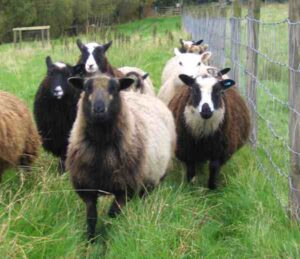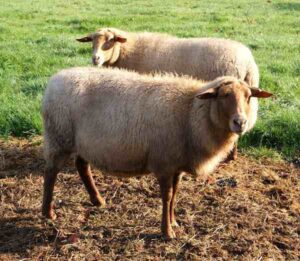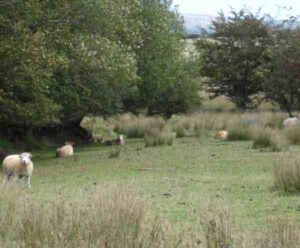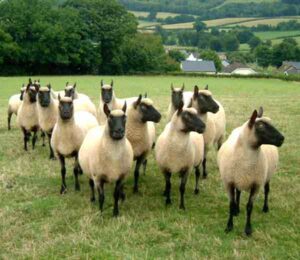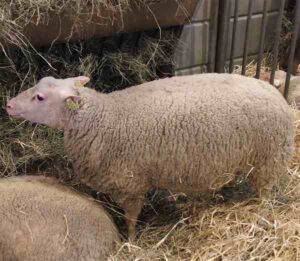Sheep horns are strong, spiral-shaped growths on the head of sheep. These horns are very strong and made of bone and covered in keratin. Horns make the sheep look very beautiful and they grow continuously throughout the sheep’s life. Apart from making the sheep beautiful, these horns have many different functions.
Sheep use their hons to fight with other sheep for establishing dominance. Especially, the rams use their horns for fighting during the mating season. But not all the sheep breeds have horns. There are some polled sheep breeds available which naturally have no horns. For example, the Merino sheep are naturally polled and they have no horns.
Structure
Sheep horns have unique structure and are very strong. The horns are very tough and flexible mainly because of the combination of bony core and a keratin sheath. The horns are of spiral shape which helps spread out the force during a fight and reduce the risk of injury.
Growth
Horn growth in the wild sheep is a natural process. But for raising sheep in farms, you have to take special care of their horns. Horns can get damaged if you don’t take good care. Perform regular checks to ensure the horns are healthy and growing well. Sometimes, you may need to trim the horns to prevent problems. Also, you have to handle the sheep carefully which have large horns. Although, we are not experts and there are still many questions regarding good horn growth in sheep. And scientists are studying how sheep horns develop and the factors influence their growth.

Different Types
Depending upon the breed, there are many different types of sheep horns. Some breeds have multiple pairs of horns, such as the Jacob sheep. While some breeds don’t have horns at all, such as Merino sheep. North American Bighorn sheep breed have large, covered hons that can weight up to 30 lbs. The Wiltshire Horn and Hebridean sheep have unique horn shapes. The type of sheep horns affect how the sheep behave and adapt to their environment.
Functions
Sheep horns have many functions. Rams generally have larger and much stronger horns than the ewes. And the rams use their horns for fighting with other rams, especially during their mating season to win over ewes. The size and strength of a ram’s horn indicates it’s strength and health condition. Sheep also use their horns for defending themselves from predators. In some cases, the attitude and big size of horns can scare off attackers and this function is very useful for wild sheep. Strong horns also help the sheep to find food by breaking through snow or dense plants.
Uses
People use sheep horns in many different ways. These horns have been used as tools, musical instruments and in rituals. The shofar is a famous example, used in Jewish religious ceremonies. The sheep horns have also been used to make combs, containers for gunpowder, buttons and some other small items.
Why do sheep have horns?
Most of the sheep breeds have horns and these horns helps the sheep in many ways. The rams have bigger horns than the ewes. Rams use their big horn to fight with other rams, especially during the mating season to win over ewes. The size and strength of a ram’s horn indicates how healthy and strong it is. Having horns over head also help the sheep to defend themselves from predators. Horns also help the sheep to find food by breaking through snow or dense plants. And in most cases big and strong horns can scare off attackers.
What are sheep horns made of?
Sheep horns are actually bony extensions covered in keratin. Keratin is the same thing in our nails and hair. Horns are permanent over a sheep’s head and keep growing throughout it’s life. There is a bony core inside the horn which is connected to the skull. There is tissue around this core which helps the horn to grow, and the outer layer is keratin. The shape and design of the horns depends on the sheep’s genes and vary from breed to breed.

Do sheep horns grow back?
No, sheep horns do not grow back once they are broken or cut off. They are permanent structures over a sheep’s head that grow continuously throughout it’s life. These horns are made of bone and is covered in keratin and they do not regenerate. They do not heal or grow back to their original form, once damaged or removed.
How to cut sheep horns?
Cutting a sheep’s horn is not easy, and you need to be very careful while doing this to avoid hurting the animal. You can call a vet or experienced person for doing this task. But if you already have experience, then go ahead. Trim the horns with a special saw or clippers which are made for this purpose. Cut off only a small part of the horn to avoid hitting the sensitive inner part that can bleed. Secure the sheep and make sure the sheep is calm during the cutting process. Always keep the tools clean to prevent infections, and doing this is very important.
Where can I find sheep horns for sale?
You can find sheep horns for sale at various places. Some farming supply stores or specialty shops that sell animal products might sell them. Check your local farms or ranches, because they sometimes sell horns from their sheep. Today, there are numerous online marketplace available from where you can purchase sheep horns. For example, eBay or Etsy often have sheep horns for sale for crafts or decoration purpose. However, always try to buy sheep horns from reputable seller or suppliers to ensure the horns are legally and ethically sourced.
Sheep horns are strong natural structures that grow throughout a sheep’s life. They make the sheep beautiful and also help the sheep to defend themselves from predators and also to scare off the attackers. Consider sharing this article with your friends and family members if you find it helpful. Good luck and may God bless you!

